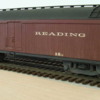Hyuk hyuk, you mean to say that after 40 years, the wooden parts have expanded/shrunk/ warped? Yes, wood is NOT a perfect medium for scale modeling. After a few years of struggling with the old Athearn and All Nation and other kits, it occurred to me that I could scratch build out of fresh bass wood much easier and with less time than it took to correct the ill fitting kit parts. I WILL say, though that Beat Hug of Old Pullman (the old Athearn line) made a great effort to have correctly fitted wooden components in his kits.
Then when you have properly fitted wood components, you realize that the ladders, hand grabs and other details seem too clunky. Sigh.
And the presence of those unsightly escutcheon pins---
Yeah.....scratch build them. I knocked myself out building a super detailed ATSF woodsided reefer when I lived in the Mojave desert. What a beauty it was! But, alas! Soon after building it, the scribed siding separated at all the joints. It shrunk up, leaving unsightly gaps. As far as I was concerned, the model was ruined. It was my last scratch build.
But after moving up near the Oregon coast, after 7 years, THE GAPS SLOWLY CLOSED! I suppose in a few more years, they may buckle!
Wooden rolling stock kits, the smell of Walthers Goo and Floquil paint have forever imprinted my memory of those halcyon days of yore! -Salty Rails-






